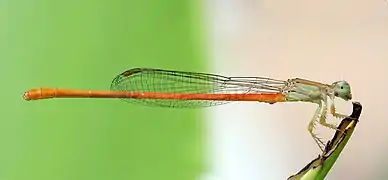Ceriagrion glabrum
Ceriagrion glabrum is a species of damselfly in the family Coenagrionidae. Its common names include common orange, common citril,[2] common pond damsel, common waxtail, orange waxtail and gewone aljander. It is widespread in Africa, where it is found in habitats that are dominated by reeds.
| Ceriagrion glabrum | |
|---|---|
 | |
| Adult male | |
| Scientific classification | |
| Domain: | Eukaryota |
| Kingdom: | Animalia |
| Phylum: | Arthropoda |
| Class: | Insecta |
| Order: | Odonata |
| Suborder: | Zygoptera |
| Family: | Coenagrionidae |
| Genus: | Ceriagrion |
| Species: | C. glabrum |
| Binomial name | |
| Ceriagrion glabrum (Burmeister, 1839) | |
| Synonyms | |
| |
Description

This is a small to medium size damselfly (length up to 46 mm (1.8 in), wingspan up to 53 mm (2.1 in)).[3] The eyes are greenish with a dark grey cap.[4] As is the case in many damselflies, this species shows strong sexual dimorphism. Males have a bright orange, unmarked abdomen and thorax, with a lighter yellow-orange colour on the sides of the abdomen.[3] Females range from brown to green to orange. They become increasingly orange with age, although they never reach the same striking brightness of the males.[5]
Distribution and habitat
This is by far the most common and widespread African Ceriagrion species.[6] It has been observed to occur in Angola, Botswana, Burkina Faso, Burundi, Cameroon, Chad, the Republic of the Congo, the Democratic Republic of the Congo, Ivory Coast, Egypt, Equatorial Guinea, Ethiopia, Gabon, Gambia, Ghana, Guinea, Kenya, Liberia, Madagascar, Malawi, Mali, Mauritius, Mozambique, Namibia, Niger, Nigeria, Réunion, São Tomé and Príncipe, Senegal, Seychelles, Sierra Leone, Somalia, South Africa, South Sudan, Tanzania, Togo, Uganda, Zambia, Zimbabwe,[1] and probably in Sudan.[6]
It is found in a variety of freshwater habitats, including marshes, ponds, dams, pans and the quiet backwaters of rivers and streams. It prefers sites that are rich in reeds, grasses and sedges.[3]
Ecology
This species sits and flies among the stems of reeds, grasses and sedge, mainly making use of low perches near the water.[3][7] Adults are only capable of short, weak flight.[7] While they are mostly found at water, they are also frequently found some distance away.[3] It can be a fierce predator of other, smaller damselflies, particularly when they are young and still soft bodied.[4]
Conservation
This species is listed as least concern by the IUCN. It is highly adaptable and readily utilises suitable artificial habitats, such as dams.[3]
References
- Boudot, J.-P.; Clausnitzer, V.; Dijkstra, K.-D.B.; Suhling, F.; Schneider, W.; Samraoui, B. (2016). "Ceriagrion glabrum". IUCN Red List of Threatened Species. 2016: e.T59828A75380384. doi:10.2305/IUCN.UK.2016-3.RLTS.T59828A75380384.en. Retrieved 12 November 2021.
- Tarboton, W.R.; Tarboton, M. (2005). A fieldguide to the damselflies of South Africa. Warwick & Michèle Tarboton. ISBN 0620338784.
- Loftie-Eaton, Megan; Hofmeyr, Sally; Tippett, Ryan; Underhill, Les (2020-05-11). "Common Citril (Ceriagrion glabrum)". BDI. Archived from the original on 2021-07-19. Retrieved 2021-07-19.
- Willis, Christopher K. (2011). Water dancers of South Africa's National Botanical Gardens : an illustrated dragonfly and damselfly checklist (PDF). Michael J. Samways, South African National Biodiversity Institute. Pretoria, South Africa: SANBI. ISBN 978-1-919976-68-6. OCLC 774322435.
- "Common Citril - Ceriagrion glabrum - Identification tips". www.dragonflies-id.co.za. Retrieved 2021-07-19.
- "ADDO -- African Dragonflies and Damselflies Online". addo.adu.org.za. Retrieved 2021-07-19.
- Picker, Mike (2019). Field guide to insects of South Africa. Charles L. Griffiths, Alan Weaving (3rd ed.). Cape Town. ISBN 978-1-77584-584-3. OCLC 1114328473.
{{cite book}}: CS1 maint: location missing publisher (link)
